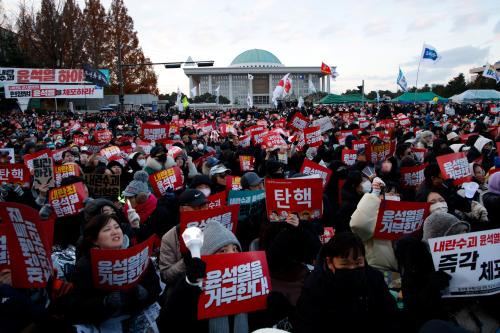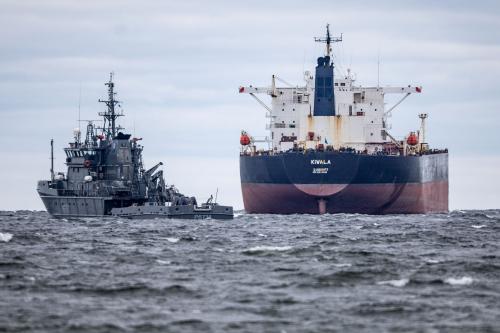As the Israeli offensive in Gaza moves south toward Khan Younis, and as some hostages come home while many more remain captive, Natan Sachs joins the podcast from Israel to reflect on the public mood, Israel’s operational goals, the ongoing threat of wider regional escalation, and what might come next.
TRANSCRIPT
PITA: After six days of a humanitarian pause at the end of November and the release of more than 100 hostages, fighting has resumed in Gaza and the Israeli offensive has expanded south toward Khan Yunis, Gaza’s second-largest city.
Joining us today from Israel to discuss the current state of the war and what might come next is Natan Sachs, senior fellow and director of the Center for Middle East Policy here at Brookings. Natan, thanks for talking to us today.
SACHS: Thanks for having me, Adrianna.
PITA: When first we spoke, you talked a lot about the psychological impact of the October 7th attacks. More than 100 hostages have been released so far, though of course not all of them have been Israeli, and many more still remain captive. What can you tell us about the public mood now in Israel two months later?
SACHS: Well, I’m in Israel at the moment and the public mood has changed. Some of the initial shock has changed into something else, something a little more sustained, routine perhaps. But there’s nothing normal about the routine. The mood is extremely somber and there is a prevailing sense, wall-to-wall that the reality has changed. Nothing is like October 6th, both because of the ongoing war, which, alongside the devastation in Gaza, also has hundreds of thousands of Israelis displaced from their homes near Gaza or near the Lebanese border. And of course, many soldiers in harm’s way. So even from the Israeli society perspective, a very traumatic time, which of course does not diminish the devastation Gaza in any way.
And the concern for the hostages. Quite a few hostages were released, but many, many more remain there. Their faces are plastered all over the towns and cities in Israel. People know their names, and of course, Israel’s not as small as it used to be, but nonetheless a small society. So, most people either know someone who was a hostage or was killed or certainly know someone who knows someone, almost without exception. And so, the mood is extremely somber, resolute in the sense of purpose. There’s a sense of righteousness, the sense of unity of cause, but also a grave concern about the future of the country that entered this unprecedented crisis even before that with a lot of internal division. So, a lot of concern, a very somber mood, a lot of people personally extremely down to say the least, but also a sense of unity and unity of purpose, at least in this short term.
PITA: One of the factors with the hostages who were taken is that there were of course many militant groups, not just Hamas who took part in the attacks and the reports were that hostages were being held now by many different actors, many different places. The reports have also recently come out about meetings between Netanyahu and some of the released captives and the families of those still held hostage in which there was a lot of anger and fear about whether or how much hostages may be in danger from the ongoing offensive and bombings. How has all of that affected the negotiations over hostages, the understanding about who’s held and where, and how that’s being accounted for?
SACHS: So, there’s an inherent tension in the Israeli goals for this war. On the one hand, Israel is of course going after Hamas, but at the same time it is trying to recover the hostages. And really the only surefire way of retrieving the hostages would be with the negotiations, primarily with Hamas. And even that would probably not suffice. There are some that Hamas is probably unwilling to release. We’ve heard the White House also state reasons, perhaps they [Hamas] are afraid of the testimony of some, especially of the younger female soldiers and female partygoers who were captive and may be undergoing hell. Moreover, for Hamas to release the full list of hostages, it would probably entail Israel releasing some of the worst terrorists in its prisons, something that Israel is not likely to do. So, this tension between the desire to release hostages and the desire to pursue the offensive against Hamas necessarily lead to a tension, and it’s coming to the fore even with these meetings with Netanyahu.
The Israeli public mood, as I said, is very much with the hostages, but also at the same time, resolute that Israel has to go after Hamas. The negotiations broke down finally, as the White House also confirmed, over Hamas’s unwillingness to follow through with the release of all the women who were eligible under the previous negotiation. And Israel was not willing to discuss other kinds of hostages and other releases until Hamas was willing to do so. Right now, negotiations, the chances of negotiations remain slim. But of course, there’s always a chance. The desire for their return certainly in Israel is immense and Hamas’ desire to see many prisoners released is immense as well. And so, there’s always a chance of negotiations, especially between the intelligence agencies that were in charge of it.
The intelligence about the hostages in the Gaza Strip is very difficult. As you said, some are held by other groups, in particular, the Palestinian Islamic Jihad. Although they released some, they are in contact with Hamas and cooperate with Hamas in that. But there were also many civilians from Gaza who followed the Hamas fighters into Israel in the second and third wave. And unfortunately, it seems that some of the hostages are in hands of perhaps criminal groups or even individuals and not all of them may be accounted for, at least that is what Hamas is claiming. The upshot of this is with such a number and their dispersion, it’s a very grim outlook. Israel is putting an enormous amount of effort into gathering intelligence about them. And of course, I don’t see that intelligence, but one can assume that a full picture and a full possibility, say, of an operational attempt to get them out, that would necessarily fall short, at least somewhat.
PITA: Outside of Hamas in Gaza, there remain concerns about how other Iran-backed proxies like Hezbollah in Lebanon and the Houthis in Yemen, how they have come into play already and whether that might escalate. What is some of the latest understanding there?
SACHS: Yeah, so we’re dealing with a horrific war, both in terms of how it started and of course in terms of its human toll right now, especially in the Gaza Strip, it’s truly staggering. But the truth is that this actually pales in comparison to the war that so far has not broken out. And I think we should all hope very much that it does not break out, but also take some solace in that some very sound policy, I think, from the United States helped prevent that. And that is a war between Hezbollah and Israel. Hezbollah is considerably stronger than Hamas. It is not clear what its intention was going in, whether it was simply going to join Hamas or whether it was going to do that only under certain circumstances. The United States, of course, entered with a show of real force and a very clear language from the president himself warning Hezbollah and other Iran-backed groups from entering the fray. And to a degree, at least so far, that has succeeded.
There is ongoing daily and quite intense fighting, of course, between Hezbollah and Israel along the Lebanese border. But it is still well below a threshold that would approach full-scale war. I should say, though, the danger remains very high. It remains high both because an operational mistake or a decision by someone on the ground could easily escalate into war, into full-scale war, which would be absolutely devastating for Lebanon and for Israel.
And secondly, because the lesson that Israelis from the top down learned on October 7th was of the danger of these very militant groups right at the border. And if Hamas was able to do what it did on October 7th, the residents at the very border with Lebanon who are now evacuated, they’re internally displaced at the moment in hotels and homes throughout Israel, it will be a very hard sell to convince them to go back home when Hezbollah is still right at the border, in contradiction to UN resolution and the agreement at the end of the 2006 Lebanon-Israel War. And so, without Hezbollah removing its fighters from the border across the Litani River, which was the resolution and agreement then, the threat of Israel also striking and trying to push Hezbollah away from the border remains very high. So as concerned as I am with everything happening in the South and in Gaza, and I am, I’m even more concerned with the possibility of a war there, which as I said in terms of sheer firepower would be an order of magnitude greater.
PITA: There’s been a lot of talk about what Israel’s goals are for the war writ large. You know, at the beginning it was just, the goal is to eliminate Hamas. And the questions are about, do they have a clear sense of what that means in a more operational sense, a more specific sense? What do we know about how the government and the military are currently defining their operational objectives and their achievability there?
SACHS: Well, there’s an enormous amount of talk from the Israeli side and you hear it also from all sorts of ministers, some of whose titles have very little to do with the substance of what they sound. The minister of intelligence in particular has been opining. She in fact has nothing to do with intelligence. Other ministers, the minister of communications has said things, he has of course nothing to do with the security either.
But if you listen to the people who are actually carrying out the operation, and that’s in particular the Ministry of Defense and the heads of the military itself, they define their operational goals as twofold. First is not to eradicate Hamas writ large. They have no illusions that Hamas will disappear because of any military operation, but rather to eliminate Hamas’s capability to govern the Gaza Strip and to carry out offensive operations such as October 7th from the Gaza Strip. And that, although extremely difficult and extremely bloody to prevent, is something that Israel’s resolute to prevent.
So, Hamas was tolerated as the ruler in Gaza in a mini quasi-independent statelet from 2007 until 2023. But at least from the Israeli perspective and to the degree that they will succeed, which is of course never guaranteed, that is something they will not tolerate again. Hamas, of course, will probably continue to carry out operations from the Gaza Strip and elsewhere, even if it doesn’t govern the Gaza Strip, but nonetheless, its ability for a decade and a half to build its infrastructure, to organize in brigades and battalions, and to carry out an operation with over a thousand troops of Hamas entering into Israel and rampaging, that has to do with its ability to govern a space, to plan, to organize, and to arm. That is what Israel is after.
The second goal, as I said before, is in some tension with it, and that’s to return all the hostages. Something that could be done in theory in negotiations with Hamas, but would be very hard to do purely militarily, and that tension remains.
PITA: I want to turn to the U.S.’s role in all of this and the potential role it could be playing. You’ve already mentioned that the overriding goal is to keep the war from escalating and from spreading throughout the region. Can you talk some more about how the Biden administration has been approaching things? The public stance has been that total alignment with Israel, the bear hug approach. What can you tell us about the U.S. administration’s ongoing goals and how and whether the scale of the devastation in Gaza is affecting their calculations about this bear hug approach to Israel, the total embrace?
SACHS: From the very beginning, you heard from the top, from President Biden, and the side, in the secretary of state and of course, the vice president, expressing complete solidarity with Israel in a way that deeply touched Israelis and also gave them a lot of political sway in Israel, which not all his predecessors had. Using that was in service of several goals. And again, there are tensions there. The first we already mentioned is preventing the dramatic escalation of this war and so far, that has been successful. We hope that will continue and that has entailed an enormous amount of effort and a very impressive show force by the United States. Something that really should not be overlooked. Of course, we’re not seeing the war that wasn’t in Lebanon and Israel, but nonetheless, the U.S. administration deserves a lot of credit even these very days right now in trying to prevent that from happening. There’s no guarantee that they will succeed or anyone else will succeed.
Their second goal early on was to stay the Israeli hand, not in terms of not going after Hamas. President Biden has said clearly that he agrees with the goal that Hamas cannot govern the Gaza Strip, that in that sense, at least, it is like ISIS, that it cannot be allowed to be a sovereign next to other states. It is a threat that cannot be tolerated. But very early on, they wanted to hear a few things from the Israelis which they did not hear. One was a clear plan of how that might be done. They hoped the Israelis would take more time to plan, to come up with an operational plan, and crucially, that that plan be both adherent to international law and to the possible minimized civilian devastation. That has had very limited success in terms of devastation of course, but it’s worth noting could have been even worse, which is very small comfort but nonetheless true.
Alongside that, the administration has been pushing very hard for humanitarian aid to go in, and there was a change in the Israeli position that was successful. Early on, the Israelis were extremely averse to providing anything for the Gaza Strip, seeing it as an enemy territory and not their responsibility. Now, the bottleneck in terms of entering is sometimes the Israelis, but sometimes not; in some issues, it’s actually the capacity of other actors to bring it in. Much, much more aid is needed, but nonetheless, there has been a change in that. The administration is still pushing. They’re hardly a successful effort, but something that has moved to a certain degree. And there’s a very able diplomat in charge of that.
Alongside that, there’s a deeper question, something that the administration has been pushing, and even just as I speak, there are American officials here in Israel working on that. And that’s the question of the day after. Even if Hamas is removed militarily, which is technically possible in the limited terms I described before, what comes next? What follows? Who governs the Gaza Strip? Would it be an open-ended Israeli occupation as it was until 2005, which the administration very strongly opposes? Or would it be something else? Would the Palestinian Authority have a role, which now Netanyahu has come out at least partially against, certainly in the short term? Might there be a possibility that American efforts at Israeli-Saudi normalization from before the war, perhaps they could now be leveraged into some kind of help for a post-Hamas Gaza Strip. All these are the very difficult tasks that the American administration has taken on.
The strategy you described, the bear hug, is to side with Israel and then nudge it in the directions that America wants. This has of course come with an enormous political cost, both in terms of young Americans and young people in general, but not just young people, certainly on the left side of the Democratic Party. And that’s something that as we enter further and further into election year, is going to be harder and harder.
There’s always a question with these conflicts of the clock, the diplomatic clock. When will the world, and primarily the United States, call it quits and try to force the parties, or at least the Israelis, to stop? And there’s also a question of the capacity of the United States to get Israel to stop. There are some things that the United States could force, but there’s a question of what. I would imagine we’re looking at a few more weeks of conflict in Gaza; probably not much more than that, at least in the full-scale sense. What follows is an open question. I don’t think we’re going to see a simple “day after” somewhere in January where everything ends. We’ll probably see a change in mode, perhaps a lessening of the height of conflict. And then the question remains, as I said before, about Lebanon. Could we see in the next few months something erupt there? I fear that the danger is certainly not gone.
PITA: All right. Well, Natan, thank you very much for talking to us today.
SACHS: My pleasure. Thank you very much, Adrianna.
The Brookings Institution is committed to quality, independence, and impact.
We are supported by a diverse array of funders. In line with our values and policies, each Brookings publication represents the sole views of its author(s).






Commentary
PodcastTaking stock of the ongoing war in Israel and Gaza
December 7, 2023
Listen on
The Current Podcast